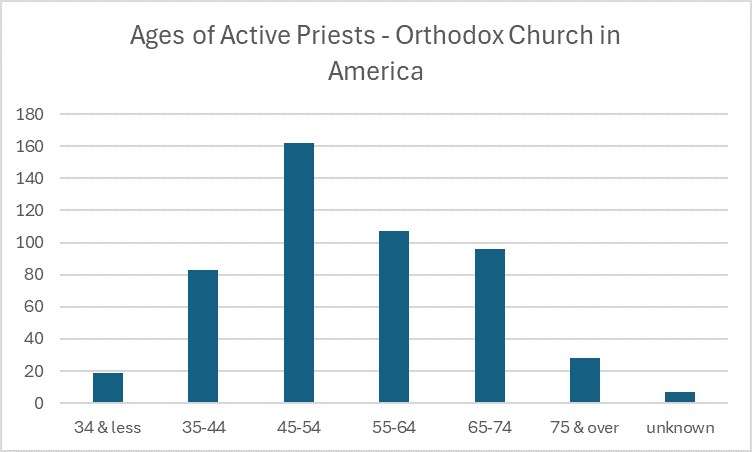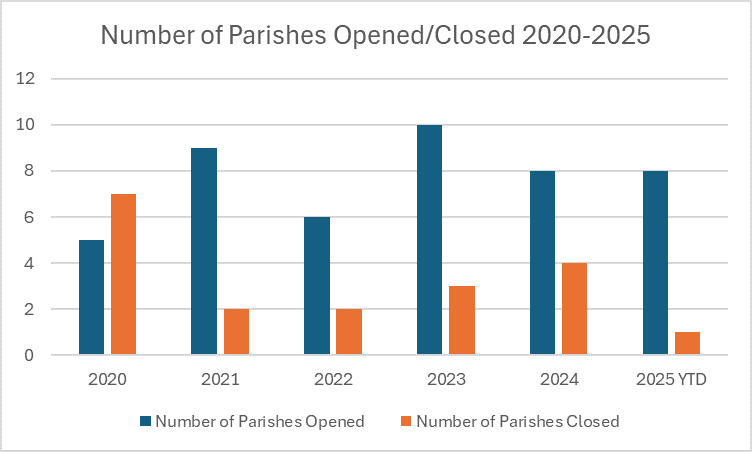Office of the Chancellor Issues Report on Clergy Data
The Chancery of the Orthodox Church in America is pleased to present up-to-date data concerning the age of our active priests and projections concerning ordinations and transfers.
The data for the age of current active priests are as follows:

34 & less: 19
35-44: 83
45-54: 162
55-64: 107
65-74: 96
75 & over: 28
Unknown: 7
Total: 502
The numbers above include 3 already retired clergy who are still listed as in charge of a congregation.
The unit of analysis was active priests for 2025, that is priests who are currently in charge of parishes serving as priests-in-charge, acting rectors, or rectors. The number of priests currently in charge of parishes in the Orthodox Church in America is 502 (priests in charge of more than one congregation are counted only once). As the graph above shows, the priests were subdivided into six age groups. A total of 124 currently active priests are at or above the conventional age of retirement (65 years). This number represents 25% of all priests. Considering the matter slightly differently, 109 priests are presently serving at or above the age of 67, which is the Full Retirement Age, as defined by the United States Social Security Administration, for people born in 1960 or later. That number represents 22% of all priests.
The total number of active priests aged 55 – 64, who will achieve retirement age within the next 10 years, is 107, or 21% of the entire number of active priests. Meanwhile, we note that the number of priests below the age of 44 is only 102, which is 20% of the total number.
Note that though there 502 active priests, there are 932 priests in the Orthodox Church in America. Discounting priests temporarily on loan, there are 907 priests. 191 of these are retired and not listed as in charge of a community, 13 are on leave of absence, 18 are suspended, and 1 has been loaned out. However, this leaves 207 priests who are serving as assistants or associates, are attached to a parish while working outside of it, are military chaplains, and so forth. It is important to remember that many of these 207 priests could become “active,” taking over a parish as a rector, at some point in the future.
Noteworthy also is the fact that 319 deacons currently serve the Orthodox Church in America, and 301 of these are active, that is, neither retired, suspended, nor on a leave of absence. The Diaconal Vocations Program currently has 81 students and at least 6 graduates awaiting ordination. Importantly, some deacons play a significant ministerial role in the life of their communities, roles that extend well beyond their strictly liturgical functions. Moreover, some number of these deacons may one day be ordained to the presbyterate, should they have both the calling and the qualifications (an M.Div. degree from an Orthodox theological seminary, or, rarely, some equivalent accepted on a case-by-case basis by the Board of Theological Education of the Orthodox Church in America). Therefore, no account of the clergy situation in the Orthodox Church in America is complete without considering our diaconate.
These figures must be further considered against the Church’s present and projected needs. The Orthodox Church in America has a total of 683 parishes (parishes, missions, and mission stations across three countries), 118 of which are without a rector. These latter are usually administered by a regional dean or appointed administrator. It must be remembered these vacancies may have any number of causes: they may be temporary, or they may be due to very small numbers, great remoteness, and so forth. Some of these communities may be drawing near to closure due to geographic and demographic realities; it should not be assumed that all or even most of these vacant parishes are prepared to support a priest, even on a somewhat limited basis.
It is worth considering in this regard that the Orthodox Church in America has opened more parishes than it has closed in the last five years, as the figure below shows. Between 2020 and 2024, 38 parishes were opened, and 18 parishes were closed, a net gain of 20 parishes. In 2025, 8 parishes have opened to date and only one has been closed. It would appear that parish openings are far outpacing parish closings. This expansion of our number of parishes suggests a general burgeoning and readiness for growth.

Looking to our seminaries, there are currently 55 Master of Divinity students from the Orthodox Church in America enrolled at Saint Vladimir’s (23) and Saint Tikhon’s Seminaries (32), and who will graduate over the next three years. That is an average of 18 potential priests per year. Additionally, St. Herman’s Seminary, a diocesan seminary educating students for ministry specifically in Alaska, currently has 15 students (10 full-time) and sees approximately 1 to 2 students ordained to the priesthood each year. At the Diocese of Mexico’s Colegio Pastoral Ortodoxo San Basilio, there are currently 8 students, all ordination track, in the program; the program has produced 9 ordained clergy already.
Therefore, if the enrollment at our seminaries remains steady over the next 10 years, then our present rate of seminary graduation and enrollment is sufficient to allow our parishes with retiring clergy to fill those positions, to permit parishes that already have openings to seek priests to fill them, and to provide for the founding of new missions in areas currently lacking an organized Orthodox presence.
Beyond our seminaries, transfers are another source of clergy for the Orthodox Church in America. As the data below shows, for the year 2024, as well as for the current year to date, Orthodox Church in America has seen more clergy transfer in than out. Clergy transfers are thus a minor but not insignificant source of younger clergy to help meet the needs of our growing communities.

In sum, a well-rounded assessment of the clergy situation of the Orthodox Church in America—one that includes our current number of priests, both active and not, as well seminarians, deacons and transfers—shows that we are not expecting to face an acute clergy shortage in the near future. Indeed, provided that we maintain and build upon our present strong efforts to increase vocations, support our seminaries, and assist our clergy families, these numbers show that the Orthodox Church in America is well-positioned to raise up clergy to meet and exceed our projected needs. These efforts, if sustained and increased, will allow us to expand our mission and reach more North Americans with the holy Gospel and the sacred Orthodox tradition.
It is important to emphasize the verbs “sustain” and “increase.” The post-COVID period has seen the rapid growth of our parishes, with many communities welcoming significant numbers of inquirers, catechumens, and new converts. To maintain their liturgical and pastoral life under the conditions of constant expansion, many communities may now or soon benefit from the presence of an assistant priest or a seminary-trained deacon. In some cases, the establishment of daughter missions or new parishes may also serve as a natural and fruitful way to meet the demands of expanding membership. In any case, careful planning, vocational support, and collaboration among dioceses will be essential to meeting this growth with sufficient clergy and other resources.
To this end, the Orthodox Church in America encourages its faithful and parishes to continue supporting our seminaries, which are critical sites for the formation of our bishops, priests, deacons, and lay leaders, unto the glory of God and the upbuilding of his holy Church.
